Two Decades of Urban Transformation and Heat Dynamics in a Desert Metropolis: Linking Land Cover, Demographics, and Surface Temperature
Abstract
1. Introduction
2. Materials and Methods
2.1. Study Area
2.2. Data
2.2.1. National Land Cover Database (NLCD)
2.2.2. Socio-Demographic Data
2.3. Land Cover Change Detection
2.4. LST Retrieval
2.5. Statistical Analysis
2.5.1. Area-Weighted Interpolation
2.5.2. Spatial Sampling
2.5.3. Weighted Least Squares (WLS) Regression
2.5.4. Multiscale Geographically Weighted Regression (MGWR)
3. Results
3.1. Spatiotemporal Dynamics of LULC Change
3.2. Associations Between LULC Change and Socio-Demographic Dynamics
3.3. LST Patterns in Relation to LULC Change
3.4. Joint Influence of LULC Change and Socio-Demographic Variables on LST Change
4. Discussion
5. Conclusions
Supplementary Materials
Author Contributions
Funding
Data Availability Statement
Conflicts of Interest
References
- Shrestha, M.K.; York, A.M.; Boone, C.G.; Zhang, S. Land Fragmentation Due to Rapid Urbanization in the Phoenix Metropolitan Area: Analyzing the Spatiotemporal Patterns and Drivers. Appl. Geogr. 2012, 32, 522–531. [Google Scholar] [CrossRef]
- Dadi, D.; Azadi, H.; Senbeta, F.; Abebe, K.; Taheri, F.; Stellmacher, T. Urban Sprawl and Its Impacts on Land Use Change in Central Ethiopia. Urban For. Urban Green. 2016, 16, 132–141. [Google Scholar] [CrossRef]
- Mockrin, M.H.; Locke, D.H.; Stewart, S.I.; Hammer, R.B.; Radeloff, V.C. Forests, Houses, or Both? Relationships between Land Cover, Housing Characteristics, and Resident Socioeconomic Status across Ecoregions. J. Environ. Manag. 2019, 234, 464–475. [Google Scholar] [CrossRef]
- Chow, W.T.L.; Chuang, W.-C.; Gober, P. Vulnerability to Extreme Heat in Metropolitan Phoenix: Spatial, Temporal, and Demographic Dimensions. Prof. Geogr. 2012, 64, 286–302. [Google Scholar] [CrossRef]
- Wang, C.; Myint, S.; Wang, Z.; Song, J. Spatio-Temporal Modeling of the Urban Heat Island in the Phoenix Metropolitan Area: Land Use Change Implications. Remote Sens. 2016, 8, 185. [Google Scholar] [CrossRef]
- Dissanayake, D.; Morimoto, T.; Murayama, Y.; Ranagalage, M.; Handayani, H.H. Impact of Urban Surface Characteristics and Socio-Economic Variables on the Spatial Variation of Land Surface Temperature in Lagos City, Nigeria. Sustainability 2018, 11, 25. [Google Scholar] [CrossRef]
- Sadiq Khan, M.; Ullah, S.; Sun, T.; Rehman, A.U.; Chen, L. Land-use/land-cover changes and its contribution to urban heat Island: A case study of Islamabad, Pakistan. Sustainability 2020, 12, 3861. [Google Scholar] [CrossRef]
- Fan, C.; Myint, S.; Kaplan, S.; Middel, A.; Zheng, B.; Rahman, A.; Huang, H.-P.; Brazel, A.; Blumberg, D. Understanding the Impact of Urbanization on Surface Urban Heat Islands—A Longitudinal Analysis of the Oasis Effect in Subtropical Desert Cities. Remote Sens. 2017, 9, 672. [Google Scholar] [CrossRef]
- Wu, W.; Li, C.; Liu, M.; Hu, Y.; Xiu, C. Change of Impervious Surface Area and Its Impacts on Urban Landscape: An Example of Shenyang between 2010 and 2017. Ecosyst. Health Sustain. 2020, 6, 1767511. [Google Scholar] [CrossRef]
- Morabito, M.; Crisci, A.; Guerri, G.; Messeri, A.; Congedo, L.; Munafò, M. Surface Urban Heat Islands in Italian Metropolitan Cities: Tree Cover and Impervious Surface Influences. Sci. Total Environ. 2021, 751, 142334. [Google Scholar] [CrossRef] [PubMed]
- Nasar-u-Minallah, M.; Haase, D.; Qureshi, S. Evaluating the Impact of Landscape Configuration, Patterns and Composition on Land Surface Temperature: An Urban Heat Island Study in the Megacity Lahore, Pakistan. Environ. Monit. Assess. 2024, 196, 627. [Google Scholar] [CrossRef]
- Soltanifard, H.; Aliabadi, K. Impact of Urban Spatial Configuration on Land Surface Temperature and Urban Heat Islands: A Case Study of Mashhad, Iran. Theor. Appl. Clim. 2019, 137, 2889–2903. [Google Scholar] [CrossRef]
- Fan, C.; Myint, S.W.; Zheng, B. Measuring the Spatial Arrangement of Urban Vegetation and Its Impacts on Seasonal Surface Temperatures. Prog. Phys. Geogr. Earth Environ. 2015, 39, 199–219. [Google Scholar] [CrossRef]
- Fan, C.; Wang, Z. Spatiotemporal Characterization of Land Cover Impacts on Urban Warming: A Spatial Autocorrelation Approach. Remote Sens. 2020, 12, 1631. [Google Scholar] [CrossRef]
- Harlan, S.L.; Brazel, A.J.; Prashad, L.; Stefanov, W.L.; Larsen, L. Neighborhood Microclimates and Vulnerability to Heat Stress. Soc. Sci. Med. 2006, 63, 2847–2863. [Google Scholar] [CrossRef] [PubMed]
- Ruddell, D.; Harlan, S.L.; Grossman-Clarke, S.; Chowell, G. Scales of Perception: Public Awareness of Regional and Neighborhood Climates. Clim. Change 2012, 111, 581–607. [Google Scholar] [CrossRef]
- Ma, W.; Jiang, G.; Li, W.; Zhou, T. How Do Population Decline, Urban Sprawl and Industrial Transformation Impact Land Use Change in Rural Residential Areas? A Comparative Regional Analysis at the Peri-Urban Interface. J. Clean. Prod. 2018, 205, 76–85. [Google Scholar] [CrossRef]
- Chi, G.; Ho, H.C. Population Stress: A Spatiotemporal Analysis of Population Change and Land Development at the County Level in the Contiguous United States, 2001–2011. Land Use Policy 2018, 70, 128–137. [Google Scholar] [CrossRef] [PubMed]
- Jia, W.; Zhao, S.; Zhang, X.; Liu, S.; Henebry, G.M.; Liu, L. Urbanization Imprint on Land Surface Phenology: The Urban–Rural Gradient Analysis for Chinese Cities. Glob. Change Biol. 2021, 27, 2895–2904. [Google Scholar] [CrossRef] [PubMed]
- Adeyeri, O.E.; Zhou, W.; Laux, P.; Wang, X.; Dieng, D.; Widana, L.A.E.; Usman, M. Land Use and Land Cover Dynamics: Implications for Thermal Stress and Energy Demands. Renew. Sustain. Energy Rev. 2023, 179, 113274. [Google Scholar] [CrossRef]
- Shahfahad; Naikoo, M.W.; Towfiqul Islam, A.R.M.d.; Mallick, J.; Rahman, A. Land Use/Land Cover Change and Its Impact on Surface Urban Heat Island and Urban Thermal Comfort in a Metropolitan City. Urban Clim. 2022, 41, 101052. [Google Scholar] [CrossRef]
- Zhou, B.; Rybski, D.; Kropp, J.P. The Role of City Size and Urban Form in the Surface Urban Heat Island. Sci. Rep. 2017, 7, 4791. [Google Scholar] [CrossRef]
- Wang, L.; Hou, H.; Weng, J. Ordinary Least Squares Modelling of Urban Heat Island Intensity Based on Landscape Composition and Configuration: A Comparative Study among Three Megacities along the Yangtze River. Sustain. Cities Soc. 2020, 62, 102381. [Google Scholar] [CrossRef]
- Fotheringham, A.S.; Yang, W.; Kang, W. Multiscale Geographically Weighted Regression (MGWR). Ann. Am. Assoc. Geogr. 2017, 107, 1247–1265. [Google Scholar] [CrossRef]
- Wang, Z.; Fan, C.; Que, X.; Liao, F.H.; Ma, X.; Wang, H. Multi-Scale Analysis of Urban Forests and Socioeconomic Patterns in a Desert City, Phoenix, Arizona. Sci. Rep. 2024, 14, 23864. [Google Scholar] [CrossRef] [PubMed]
- Zhou, D.; Zhao, S.; Liu, S.; Zhang, L.; Zhu, C. Surface urban heat island in China’s 32 major cities: Spatial patterns and drivers. Remote Sens. Environ. 2014, 152, 51–61. [Google Scholar] [CrossRef]
- Li, X.; Zhou, Y.; Asrar, G.R.; Imhoff, M.; Li, X. The surface urban heat island response to urban expansion: A panel analysis for the conterminous United States. Sci. Total Environ. 2017, 605, 426–435. [Google Scholar] [CrossRef] [PubMed]
- Kottek, M.; Grieser, J.; Beck, C.; Rudolf, B.; Rubel, F. World Map of the Köppen-Geiger Climate Classification Updated. Meteorol. Z. 2006, 15, 259–263. [Google Scholar] [CrossRef]
- Fan, C.; Myint, S.W.; Rey, S.J.; Li, W. Time series evaluation of landscape dynamics using annual Landsat imagery and spatial statistical modeling: Evidence from the Phoenix metropolitan region. Int. J. Appl. Earth Obs. Geoinf. 2017, 58, 12–25. [Google Scholar] [CrossRef]
- Cilek, A.; Unal, M.; Middel, A. The Effects of 2-D and 3-D Urban Landscape Metrics on Mean Radiant Temperature in Hot-Arid Phoenix and Tempe, Arizona, USA. Sustain. Cities Soc. 2024, 101, 105116. [Google Scholar] [CrossRef]
- Brazel, A.; Selover, N.; Vose, R.; Heisler, G. The Tale of Two Climates-Baltimore and Phoenix Urban LTER Sites. Clim. Res. 2000, 15, 123–135. [Google Scholar] [CrossRef]
- Comus, P.W.; Phillips, S.J.; Dimmitt, M.A.; Brewer, L.M. (Eds.) A Natural History of the Sonoran Desert; University of California Press: Oakland, CA, USA, 2015. [Google Scholar]
- Berling-Wolff, S.; Wu, J. Modeling urban landscape dynamics: A case study in Phoenix, USA. Urban Ecosyst. 2004, 7, 215–240. [Google Scholar] [CrossRef]
- Olgun, R.; Karakuş, N.; Selim, S.; Yilmaz, T.; Erdoğan, R.; Aklıbaşında, M.; Dönmez, B.; Çakır, M.; Ardahanlıoğlu, Z.R. Impacts of Landscape Composition on Land Surface Temperature in Expanding Desert Cities: A Case Study in Arizona, USA. Land 2025, 14, 1274. [Google Scholar] [CrossRef]
- Golden, J.S. The Built Environment Induced Urban Heat Island Effect in Rapidly Urbanizing Arid Regions—A Sustainable Urban Engineering Complexity. Environ. Sci. 2004, 1, 321–349. [Google Scholar] [CrossRef]
- Zang, S.; Wu, C.; Liu, H.; Na, X. Impact of Urbanization on Natural Ecosystem Service Values: A Comparative Study. Environ. Monit. Assess. 2011, 179, 575–588. [Google Scholar] [CrossRef]
- Huang, G.; Cadenasso, M.L. People, Landscape, and Urban Heat Island: Dynamics among Neighborhood Social Conditions, Land Cover and Surface Temperatures. Landsc. Ecol. 2016, 31, 2507–2515. [Google Scholar] [CrossRef]
- Homer, C.G.; Fry, J.A.; Barnes, C.A. The National Land Cover Database; U.S. Geological Survey: Reston, VA, USA, 2012. [Google Scholar]
- Yang, L.; Jin, S.; Danielson, P.; Homer, C.; Gass, L.; Bender, S.M.; Case, A.; Costello, C.; Dewitz, J.; Fry, J.; et al. A New Generation of the United States National Land Cover Database: Requirements, Research Priorities, Design, and Implementation Strategies. ISPRS J. Photogramm. Remote Sens. 2018, 146, 108–123. [Google Scholar] [CrossRef]
- U.S. Census Bureau. Census.Gov|U.S. Census Bureau Homepage. Available online: https://www.census.gov (accessed on 8 August 2025).
- Ermida, S.L.; Soares, P.; Mantas, V.; Göttsche, F.-M.; Trigo, I.F. Google Earth Engine Open-Source Code for Land Surface Temperature Estimation from the Landsat Series. Remote Sens. 2020, 12, 1471. [Google Scholar] [CrossRef]
- Duguay-Tetzlaff, A.; Bento, V.; Göttsche, F.; Stöckli, R.; Martins, J.; Trigo, I.; Olesen, F.; Bojanowski, J.; Da Camara, C.; Kunz, H. Meteosat Land Surface Temperature Climate Data Record: Achievable Accuracy and Potential Uncertainties. Remote Sens. 2015, 7, 13139–13156. [Google Scholar] [CrossRef]
- Qin, Z.; Karnieli, A.; Berliner, P. A Mono-Window Algorithm for Retrieving Land Surface Temperature from Landsat TM Data and Its Application to the Israel-Egypt Border Region. Int. J. Remote Sens. 2001, 22, 3719–3746. [Google Scholar] [CrossRef]
- Jesdale, B.M.; Morello-Frosch, R.; Cushing, L. The racial/ethnic distribution of heat risk–related land cover in relation to residential segregation. Environ. Health Perspect. 2013, 121, 811–817. [Google Scholar] [CrossRef] [PubMed]
- Morello-Frosch, R.; Lopez, R. The riskscape and the color line: Examining the role of segregation in environmental health disparities. Environ. Res. 2006, 102, 181–196. [Google Scholar] [CrossRef]
- Malakar, N.K.; Hulley, G.C.; Hook, S.J.; Laraby, K.; Cook, M.; Schott, J.R. An operational land surface temperature product for Landsat thermal data: Methodology and validation. IEEE Trans. Geosci. Remote Sens. 2018, 56, 5717–5735. [Google Scholar] [CrossRef]
- Wu, J.; David, J.L. A Spatially Explicit Hierarchical Approach to Modeling Complex Ecological Systems: Theory and Applications. Ecol. Model. 2002, 153, 7–26. [Google Scholar] [CrossRef]
- Oshan, T.M.; Li, Z.; Kang, W.; Wolf, L.J.; Fotheringham, A.S. MGWR: A Python implementation of multiscale geographically weighted regression for investigating process spatial heterogeneity and scale. ISPRS Int. J. Geo-Inf. 2019, 8, 269. [Google Scholar] [CrossRef]
- Buyantuyev, A.; Wu, J. Urban Heat Islands and Landscape Heterogeneity: Linking Spatiotemporal Variations in Surface Temperatures to Land-Cover and Socioeconomic Patterns. Landsc. Ecol. 2010, 25, 17–33. [Google Scholar] [CrossRef]
- Wu, J.; Jenerette, G.D.; Buyantuyev, A.; Redman, C.L. Quantifying Spatiotemporal Patterns of Urbanization: The Case of the Two Fastest Growing Metropolitan Regions in the United States. Ecol. Complex. 2011, 8, 1–8. [Google Scholar] [CrossRef]
- Elmarakby, E.; Khalifa, M.; Elshater, A.; Afifi, S. Tailored methods for mapping urban heat islands in Greater Cairo Region. Ain Shams Eng. J. 2022, 13, 101545. [Google Scholar] [CrossRef]
- He, R.; Wang, J.; Liu, D. Assessing the Impact of Urban Spatial Form on Land Surface Temperature Using Random Forest—Taking Beijing as a Case Study. Land 2025, 14, 1639. [Google Scholar] [CrossRef]
- Williams, S.A.; Hipp, J.R. The Shape of Neighborhoods to Come: Examining Patterns of Gentrification and Holistic Neighborhood Change in Los Angeles County, 1980–2010. Environ. Plan. A Econ. Space 2022, 54, 265–294. [Google Scholar] [CrossRef]
- Wang, Z.; Fan, C.; Zhao, Q.; Myint, S.W. A Geographically Weighted Regression Approach to Understanding Urbanization Impacts on Urban Warming and Cooling: A Case Study of Las Vegas. Remote Sens. 2020, 12, 222. [Google Scholar] [CrossRef]
- Alshehri, F.; Abuamarah, B.A.; Abd El-Hamid, H.T. Impact of Land Use Dynamics on Land Surface Temperature Using Optical Remote Sensing Data Integrated with Statistical Analysis in Riyadh, Saudi Arabia. Adv. Space Res. 2023, 72, 1739–1750. [Google Scholar] [CrossRef]
- Zhang, X.; Zhang, J. Exploring the Impact of Urban Characteristics on Diurnal Land Surface Temperature Based on LCZ and Machine Learning. Land 2025, 14, 1813. [Google Scholar] [CrossRef]
- Gunawardena, K.R.; Wells, M.J.; Kershaw, T. Utilising Green and Bluespace to Mitigate Urban Heat Island Intensity. Sci. Total Environ. 2017, 584–585, 1040–1055. [Google Scholar] [CrossRef] [PubMed]
- Pahl-Weber, E.; Ohlenburg, H.; Seelig, S.; Kuhla von Bergmann, N.; Schäfer, R. Urban Challenges and Urban Design Approaches for Resource-Efficient and Climate-Sensitive Urban Design in the MENA Region; Universitätsverlag der TU Berlin: Berlin, Germany, 2013; Volume 5, ISBN 3-7983-2534-0. [Google Scholar]
- Cool Pavement Program. Available online: https://www.phoenix.gov/administration/departments/streets/initiatives/pavement-maintenance/cool-pavement-program.html (accessed on 8 August 2025).
- Middel, A.; Vanos, J.; Kaloush, K.; Medina, J.; Sailor, D.; Campbell, B.; Karam, J.; Napogbong, L.; Lartey, P.; Alhozaimy, M.; et al. Cool Pavement Pilot Program: Joint Study Between the City of Phoenix and Arizona State University; City of Phoenix/Arizona State University: Phoenix, AZ, USA, 2021. [Google Scholar]
- Second Study Says Phoenix’s ‘Cool Pavement’ Has Positive Effect So Far. Available online: https://www.azfamily.com/2024/10/18/second-study-says-phoenixs-cool-pavement-has-positive-effect-so-far/ (accessed on 8 August 2025).
- Middel, A.; Vanos, J.; Kaloush, K.; Medina, J.; Sailor, D.; Campbell, B.; Karam, J.; Napogbong, L.; Lartey, P.; Alhozaimy, M.; et al. City of Phoenix Cool Pavement Pilot Program Phase II—2022; City of Phoenix/Arizona State University: Phoenix, AZ, USA, 2024. [Google Scholar]
- Mohammed, A.; Khan, A.; Santamouris, M. On the mitigation potential and climatic impact of modified urban albedo on a subtropical desert city. Build. Environ. 2021, 206, 108276. [Google Scholar] [CrossRef]
- Abulibdeh, A. Analysis of urban heat island characteristics and mitigation strategies for eight arid and semi-arid gulf region cities. Environ. Earth Sci. 2021, 80, 259. [Google Scholar] [CrossRef]
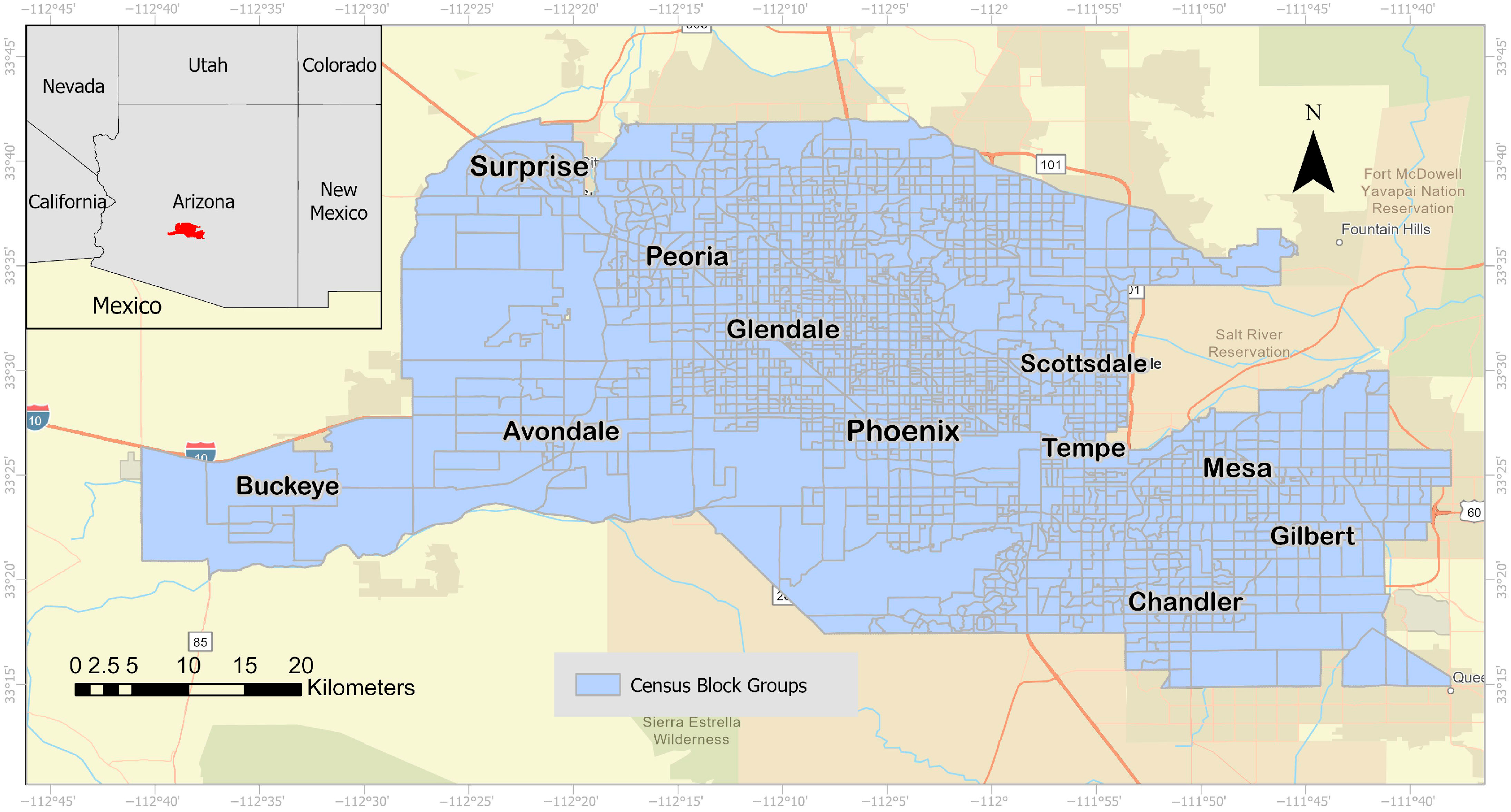

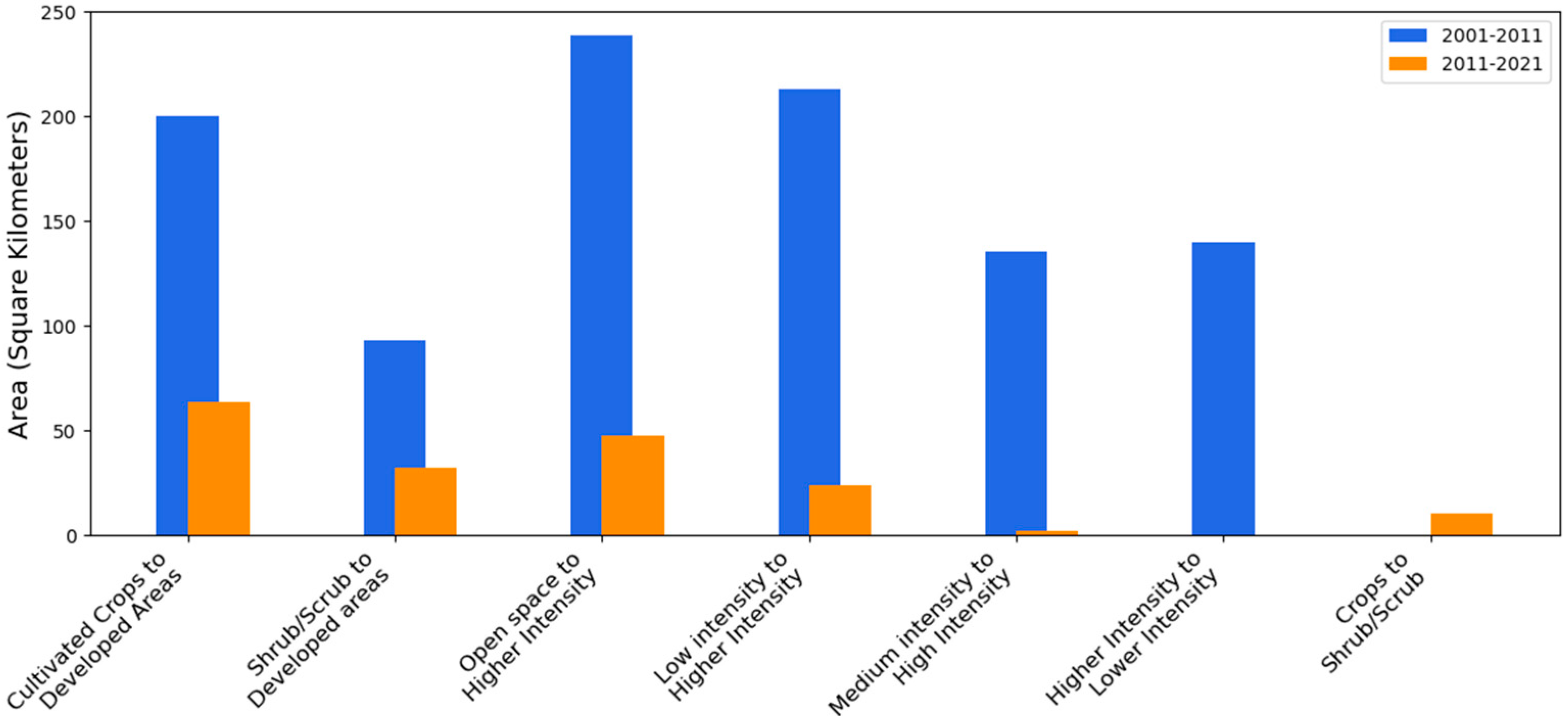
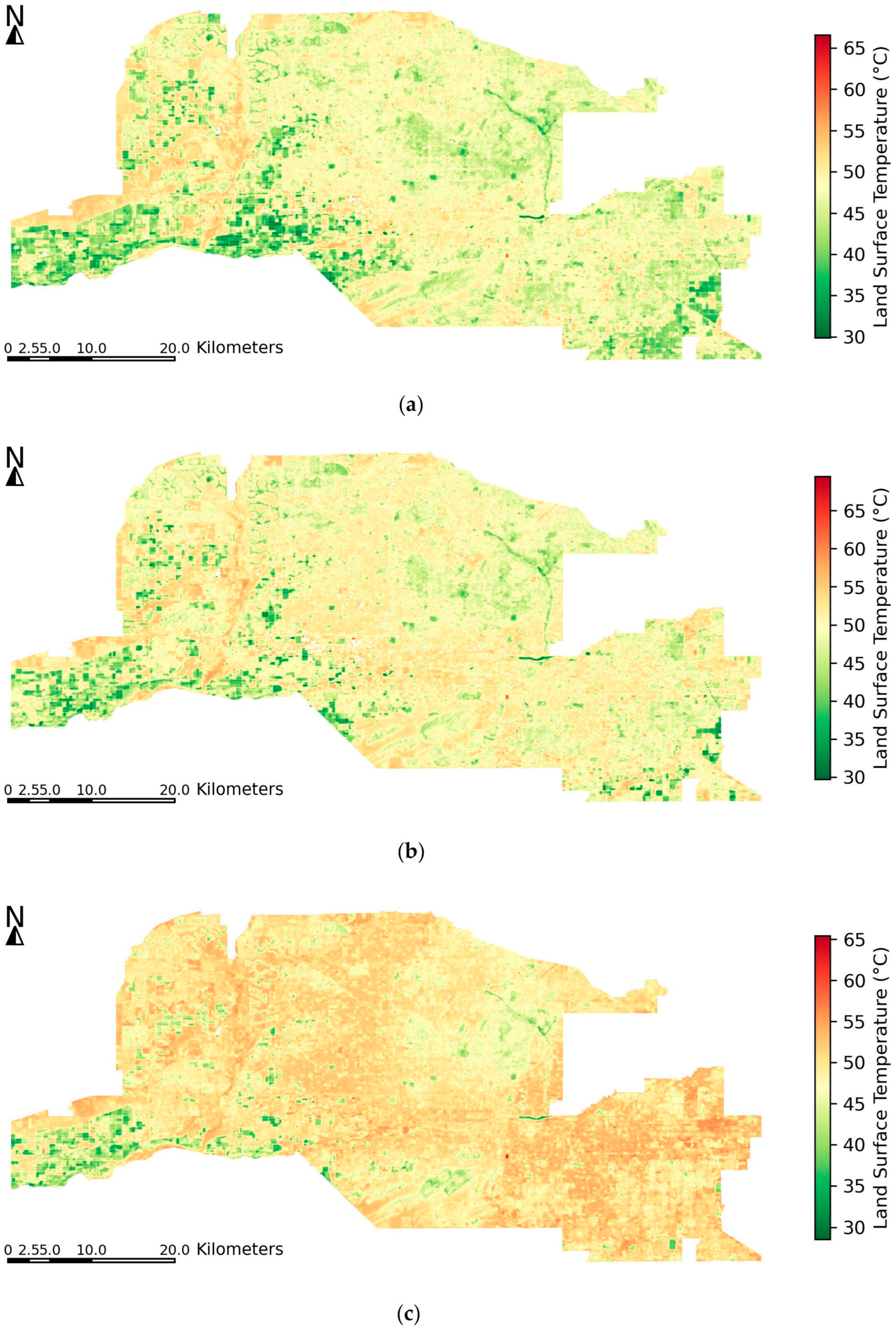

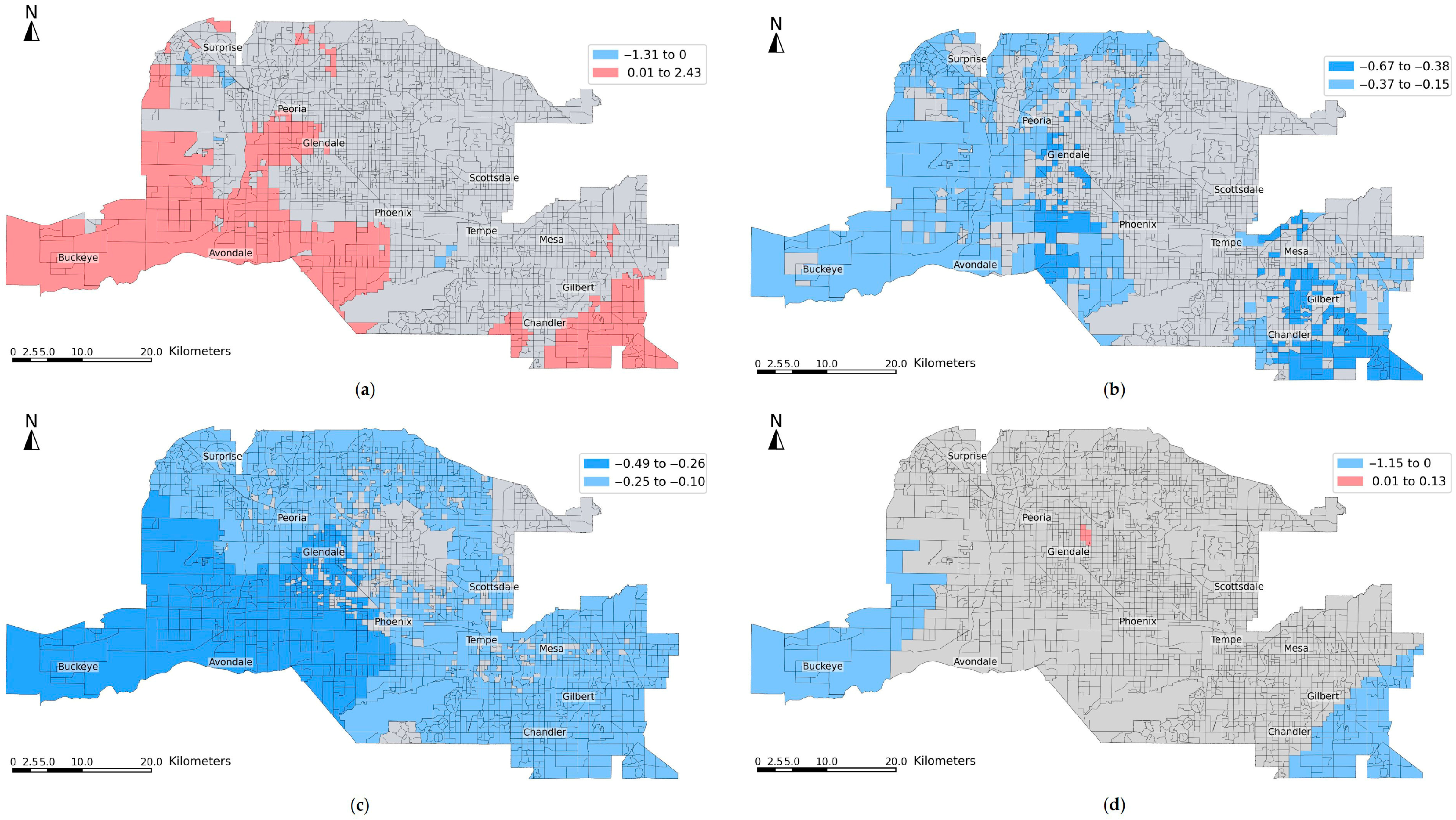
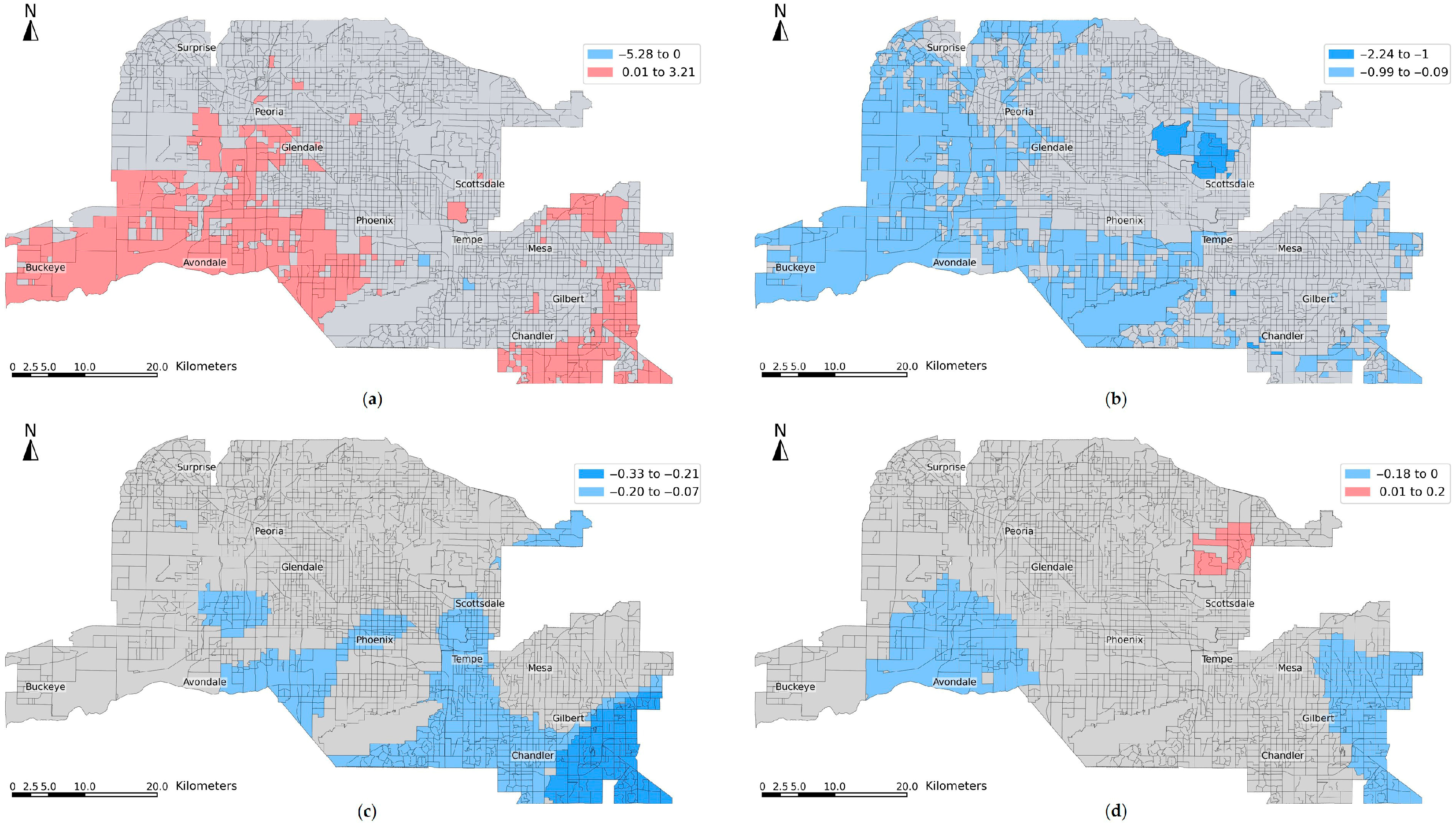
| 2001 | 2011 | 2021 | ||||
|---|---|---|---|---|---|---|
| Mean | Std. Dev. | Mean | Std. Dev. | Mean | Std. Dev. | |
| Total population | 1435 | 979 | 1531 | 688 | 1544 | 713 |
| White | 1099 | 854 | 1220 | 566 | 709 | 392 |
| Hispanic or Latino | 369 | 435 | 488 | 514 | 483 | 303 |
| Black | 55 | 84 | 84 | 132 | 83 | 76 |
| Asian | 32 | 45 | 55 | 95 | 57 | 74 |
| Residents with a bachelor’s degree or higher | N/A | N/A | 296 | 243 | 353 | 284 |
| Median household income | 47,471 | 23,710 | 57,106 | 30,163 | 70,318 | 39,041 |
| Median housing value | N/A | N/A | 171,752 | 134,435 | 276,307 | 195,681 |
| Housing units | 577 | 440 | 645 | 284 | 630 | 296 |
| POP | White | Hispanic/ Latino | Black | Asian | MHI 1 | HU 2 | |
|---|---|---|---|---|---|---|---|
| Crops to Developed | 0.52 | 0.47 | 0.4 | 0.42 | 0.29 | 0.16 | 0.45 |
| Shrub/Scrub to Developed | 0.17 | 0.16 | 0.17 | 0.16 | |||
| Open Space to Higher-Dev | 0.15 | 0.14 | 0.14 | 0.15 | |||
| Low-Dev to Higher-Dev | −0.31 | −0.28 | −0.24 | −0.24 | −0.22 | −0.11 | −0.25 |
| Medium-Dev to Higher-Dev | −0.19 | −0.16 | −0.15 | −0.15 | −0.1 | −0.22 | −0.16 |
| Higher-Dev to Lower-Dev | −0.37 | −0.33 | −0.31 | −0.26 | −0.21 | −0.1 | −0.3 |
| POP | White | Asian | Bachelor | MHI 1 | HU 2 | |
|---|---|---|---|---|---|---|
| Crops to Developed | 0.2 | 0.13 | 0.14 | 0.13 | 0.15 | 0.18 |
| Shrub/Scrub to Developed | 0.19 | 0.16 | 0.18 | 0.13 | 0.1 | 0.16 |
| Open Space to Higher-Dev | 0.24 | 0.22 | 0.14 | 0.16 | 0.24 | |
| Low-Dev to Higher-Dev | 0.14 | 0.16 | ||||
| Medium-Dev to Higher-Dev | 0.11 |
| 2001–2011 | 2011–2021 | |||||||
|---|---|---|---|---|---|---|---|---|
| LST Change | Lower CI | Higher CI | p | LST Change | Lower CI | Higher CI | p | |
| Crops to Developed | +5.146 | +4.8 | +5.492 | <0.001 | +3.151 | +2.731 | +3.571 | <0.001 |
| Shrub/Scrub to Developed | +0.39 | +0.249 | +0.537 | <0.001 | −2.395 | −2.246 | −2.543 | <0.001 |
| Open Space to Higher-Dev | +1.829 | +1.709 | +1.949 | <0.001 | −0.156 | −0.009 | −0.322 | 0.064 |
| Low-Dev to Higher-Dev | +2.568 | +2.493 | +2.643 | <0.001 | −0.08 | −0.041 | −0.201 | 0.197 |
| Medium-Dev to Higher-Dev | +2.346 | +2.271 | +2.42 | <0.001 | −0.029 | −0.127 | 0.069 | 0.563 |
| Crops to Shrub/Scrub | +2.514 | +2.433 | +2.594 | <0.001 | +1.502 | +1.207 | +1.797 | <0.001 |
| 2001–2011 | ||||
|---|---|---|---|---|
| Predictor | Standardized Coefficient | Std. Error | t | VIF |
| Percent Crops to Developed | 0.42 * | 0.003 | 12.984 | 1.402 |
| Percent Shrub/Scrub to Developed | −0.345 * | 0.002 | −12.016 | 1.104 |
| Percent Open Space to Higher-Dev | −0.221 * | 0.003 | −7.946 | 1.03 |
| Change in Total Pop | −0.386 * | 0.000 | −8.37 | 2.839 |
| Change in Black | 0.086 * | 0.000 | 2.708 | 1.342 |
| Change in Asian | −0.045 | 0.001 | −1.157 | 2.042 |
| Adjusted R2: 0.363 | ||||
| 2011–2021 | ||||
|---|---|---|---|---|
| Predictor | Standardized Coefficient | Std. Error | t | VIF |
| Percent Crops to Developed | 0.476 * | 0.006 | 15.692 | 1.042 |
| Percent Shrub/Scrub to Developed | −0.206 * | 0.015 | −6.811 | 1.032 |
| Percent Low-Dev to Higher-Dev | −0.148 * | 0.027 | −4.968 | 1.002 |
| Change in Total Pop | −0.084 * | 0.000 | −2.734 | 1.059 |
| Adjusted R2: 0.266 | ||||
| 2001–2011 | 2011–2021 | |||||
|---|---|---|---|---|---|---|
| WLS | GWR | MGWR | WLS | GWR | MGWR | |
| R2 | 0.367 | 0.397 | 0.545 | 0.27 | 0.579 | 0.651 |
| AICc | 6118.549 | 5659.279 | 5272.921 | 7036.484 | 5397.513 | 5023.368 |
| 2001–2011 | 2011–2021 | |||
|---|---|---|---|---|
| Mean Coefficient (Sig.) | Bandwidth | Mean Coefficient (Sig.) | Bandwidth | |
| Percent Crops to Developed | 0.792 | 49 | 0.729 | 43 |
| Percent Shrub/Scrub to Developed | −0.338 | 491 | −0.519 | 331 |
| Percent Open Space to Higher-Dev | −0.217 | 501 | ||
| Percent Low-Dev to Higher-Dev | −0.158 | 43 | ||
| Change in Total Pop | −0.093 | 49 | −0.099 | 43 |
| Change in Black | N/A | 2381 | ||
| Change in Asian | N/A | 2387 | ||
Disclaimer/Publisher’s Note: The statements, opinions and data contained in all publications are solely those of the individual author(s) and contributor(s) and not of MDPI and/or the editor(s). MDPI and/or the editor(s) disclaim responsibility for any injury to people or property resulting from any ideas, methods, instructions or products referred to in the content. |
© 2025 by the authors. Licensee MDPI, Basel, Switzerland. This article is an open access article distributed under the terms and conditions of the Creative Commons Attribution (CC BY) license (https://creativecommons.org/licenses/by/4.0/).
Share and Cite
Fan, C.; Prothan, M.J.I.J.; Zhu, Y.; Shi, D. Two Decades of Urban Transformation and Heat Dynamics in a Desert Metropolis: Linking Land Cover, Demographics, and Surface Temperature. Land 2025, 14, 2141. https://doi.org/10.3390/land14112141
Fan C, Prothan MJIJ, Zhu Y, Shi D. Two Decades of Urban Transformation and Heat Dynamics in a Desert Metropolis: Linking Land Cover, Demographics, and Surface Temperature. Land. 2025; 14(11):2141. https://doi.org/10.3390/land14112141
Chicago/Turabian StyleFan, Chao, Md Jakirul Islam Jony Prothan, Yuanhui Zhu, and Di Shi. 2025. "Two Decades of Urban Transformation and Heat Dynamics in a Desert Metropolis: Linking Land Cover, Demographics, and Surface Temperature" Land 14, no. 11: 2141. https://doi.org/10.3390/land14112141
APA StyleFan, C., Prothan, M. J. I. J., Zhu, Y., & Shi, D. (2025). Two Decades of Urban Transformation and Heat Dynamics in a Desert Metropolis: Linking Land Cover, Demographics, and Surface Temperature. Land, 14(11), 2141. https://doi.org/10.3390/land14112141







